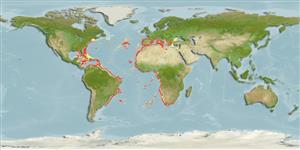Malacostraca |
Decapoda |
Pandalidae
Environment: milieu / climate zone / εύρος βάθους / distribution range
Οικολογία
; εύρος βάθους 190 - 1550 m (Αναφ. 106425), usually 500 - 750 m (Αναφ. 106425). Subtropical; 45°N - 38°S, 89°W - 34°E
Atlantic Ocean and the Mediterranean: From Portugal to South Africa (West African waters from 16° to 28°S) and Straits of Florida to Turkey.
Length at first maturity / Μέγεθος / Weight / Age
Γεννητική Ωρίμανση: Lm ? range ? - ? cm Max length : 8.5 cm TL αρσενικό/απροσδιόριστο; (Αναφ. 804)
Found on the middle continental slope (Ref. 105377). Non-migrator macrozooplankton feeder (Ref. 52384). Active predator of macroplankton species. Diet is based on smaller prey like siphonophores, hyperiids and euphausiids (Ref. 105341).
Life cycle and mating behavior
Γεννητική Ωρίμανση | Αναπαραγωγή | Γεννοβολία | Eggs | Γονιμότητα | Larvae
Members of the order Decapoda are mostly gonochoric. Mating behavior: Precopulatory courtship ritual is common (through olfactory and tactile cues); usually indirect sperm transfer.
Bianchi, G., K.E. Carpenter, J.-P. Roux, F.J. Molloy, D. Boyer and H.J. Boyer 1999 FAO species identification guide for fishery purposes. Field guide to the living marine resources of Namibia. Rome, FAO. 265 p., 11 plates. (Αναφ. 804)
IUCN Red List Status
(Αναφ. 130435: Version 2025-1)
CITES status (Αναφ. 108899)
Not Evaluated
Not Evaluated
Threat to humans
Human uses
| FishSource |
Εργαλεία
Περισσότερες πληροφορίες
Life cycleΑναπαραγωγήΓεννητική ΩρίμανσηΓονιμότηταΓεννοβολίαEggsEgg developmentLarvae PhysiologyΚατανάλωση οξυγόνου
Human RelatedStamps, coins, misc.
Διαδικτυακές πηγές
Estimates based on models
Preferred temperature
(Ref.
115969): 5.9 - 14.3, mean 13.5 (based on 76 cells).
Ελαστικότητα
Υψηλό, ελάχιστος χρόνος για διπλασιασμό πληθυσμού < 15 μήνες (K=0.5-0.55).
Fishing Vulnerability
Low vulnerability (24 of 100).
